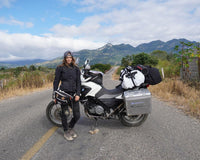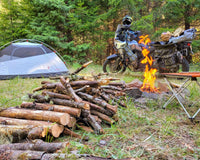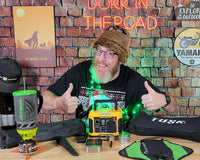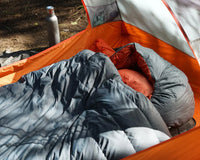What is Dispersed Camping?
Also referred to as Boondocking, Coyote Camping, Free Camping, Wild Camping.
Dispersed camping is the term used for camping anywhere on National Forest, National Grasslands or Bureau of Land Management land -unless otherwise noted- outside of a designated campground.
Dispersed camping means there is no infrastructure you would normally find in a campground. There are no toilets, no picnic tables, no trash cans, no treated water, and no fire grates. So it is imperative to follow leave no trace principles. Do not leave Trash, pack out all of your food waste, pack out your toilet paper (and in some desert environments -pack out your poop.)
If you want a dispersed camp in the winter, recognize that the Forest Service does not plow or maintain Forest Roads in the winter, so plan your trip accordingly.
Where can you Dispersed Camp?
There are a few different kinds of public land that allow Dispersed Camping, unless otherwise noted by signage, a ranger, or rules listed on the respective website. It is not legal to dispersed camp on ALL Public Lands, there are some exceptions. It is very important to do your research, and know before you go.
- Some National Forests
- BLM (Bureau of Land Management)
- Some Wildlife Management Areas (web search "WMA <state name>")
- Some State Trust Land
- Some State Forests
- Some State Parks
- Some National Grasslands
If you're confused about what the difference between each of these kinds of Public Lands please refer to the USA Public Lands 101 Article

What are the General Rules?
You may not travel more than 300 feet from a designate road
Dispersed Campers are only allowed to stay a max of 14 days in a 30 day period. These rules are different depending on what authority runs the land, and what state you're in, but 14 days max is a good rule to go by. You can not return to camp in that area for 28 days.
You have to be a minimum of at least 100-200 feet away from any road, trail or water source.
Don't camp in the middle of a clearing or a meadow. Make your campsite less visible so that other visitors will see a wild setting. Specific lands like Badlands National Park require that you can not be visible from the road.
Camp on bare soil if possible, to avoid damaging or killing plants and grass. Choose sites that are already clearly established and have been used by others.
Don't try to leave or dig trenches in the ground at your campsite. Select a campsite with good natural drainage.
Considerations and Things to be Aware of
Different States have different laws about Dispersed Camping.
Examples of excluded or special restriction zones like State Parks, National Parks, County Parks, Private Utility Company Land, City Parks, Private Conservation Land and Land that borders National Parks also have camping restrictions to prevent overuse.
Logging Leases, and Private Property normally has signage.
Notify Rangers of where you'll be and an emergency contact.
Do research and get a permit if you need one, even if it's free. Ranger Stations are excellent resources for information if you're confused, or can't find the information online.
Overnight camping is often not allowed at Trailheads, picnic areas, day-use areas -unless otherwise noted.
We recommend not planning on making a campfire.
National Forest Land does allow campfires when there's not a fire ban, however starting a campfire while dispersed camping is not allowed on BLM Land if there is not an existing official fire pit.
Many wildfires are caused by human activity, typically escaped campfires from dispersed campers. Campfires are allowed when you are dispersed camping UNLESS there are fire restrictions in effect due to high fire danger conditions. It is YOUR responsibility to know if fire restrictions are in effect before you go camping.
Be prepared with warm gear, and cook food with a camping stove and self contained fuel canisters.
If you do make a fire; always check current fire conditions and stay up to date on fire bans.
It is illegal to transport firewood across state lines. Buy or collect firewood locally. Never leave a fire unattended and make sure to dowse it with a lot of water when you decide to put it out. Churn the earth and touch the dirt. If the ground is still warm, it's at risk for a fire starting. Put more water on it, until it is cool to the touch.
Dispersed Camping means there are no Toilets. Make sure you protect water sources by taking extra care of where and how you dispose of human waste. How you treat your poop varies depending on the environment you're in and the amount of usage that area sees.
If you're in a wooded environment that doesn't see an excess of visitors, dig a cat hole 6" deep, 200 feet away from any water source, and pack out your toilet paper with your trash.
However if you're in a high traffic area (ie around National Parks and other Popular Recreational Areas), or in delicate ecosystems like the desert and alpine areas, it is recommended you use a plastic bag, a wag bag or waste bag and pack out your poop.

Think about what you're doing with your food and waste water.
Whether it's washing your body or washing your dishes. Dispose of water at least 200 feet away from any water source, do not use any soap directly in a water source, and use biodegradable soaps. If you can help it, do not pour dishwater in one spot, try and throw it a wide arc, so as not to create a single spot of food smells.
Be Bear Aware.
It is very important to check if you'll be camping in a bear active area. Most bear active areas require you to carry a bear canister, or have access to bear proof food storage. It's also a good idea to carry bear spray.
Dispersed Camping is an excellent way to camp for free when you don't have the means to pay for a camp site and/or experience the outdoors without the trappings of civilization.
You don’t need to geotag or describe in depth on social media where you camp. This only encourages over usage. Usage of public lands has increased substantially. Not everyone who learns about where you go will go there and treat the land with as much LNT knowledge or care as you do. Often this is how the most damage to our public lands occurs, and how many areas are closed to public access. Avoid oversharing to keep wild places wild, and leave places better than you found them. If you have the room, try to pack out any trash you find even if you didn't leave it there.
Please share this information with fellow riders and campers. Respect the land so that we can continue to use these free resources.





























